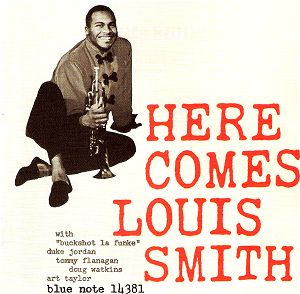1, Tribute to Brownie
2. Brill's Blues
3. Ande
4. Star Dust
5. South Side
6. Val's Blues
Louis Smith - Trumpet
Cannonball Adderley - Alto sax
Duke Jordan - Piano (tracks 1, 2, 5)
Tommy Flanagan - Piano (tracks 3, 4, 6)
Doug Watkins - Bass
Art Taylor - Drums
When I reviewed Horace Silver's
album Live in Newport '58 for this
website (www.musicweb-international.com/jazz/2008/silver_09463980702.htm),
I was particularly impressed by a trumpeter
I hadn't heard before, His name was Louis
Smith and he only played briefly for Horace
Silver before returning to his job as a teacher.
He had previously made a couple of albums
which were released by Blue Note: this is
the first of them, recorded in 1957 with Cannonball
Adderley, who apparently disguised himself
under the pseudonym of Buckshot La Funke.
The album opens with Tribute
to Brownie, underlining Louis Smith's
resemblance to Clifford Brown. Clifford had
died in 1956 and there were hopes that Louis
Smith might become his natural successor.
Both trumpeters had formidable techniques,
played with estimable clarity, and structured
their solos with an audible affiliation with
the blues. Tribute to Brownie opens
with Louis playing with only the backing of
Art Taylor's drums. Cannonball Adderley joins
in for a very beboppish outing, then contributes
a typically fluent, swirling solo. The tune
was written by Duke Pearson, who adds a clear-lined
piano solo.
Louis's trumpet is bluesily
funky in Brill's Blues, so titled because
the original recording sessions took place
at the Brill Building in Manhattan. This is
the first of four original compositions by
Smith - the only other non-original is Hoagy
Carmichael's Star Dust, which demonstrates
Louis's ability to deliver a ballad with sensitivity.
He sounds as eloquent and inventive as Clifford
Brown ever did. Adderley lays out for this
number, leaving the limelight to Louis.
Ande was written and
named for Smith's wife, although it is based
on the chord sequence of Indiana. Tommy
Flanagan takes over the piano stool for this
and two other numbers, showing how he could
combine urbanity with his understanding of
bebop. Smith and Adderley blend beautifully
in the theme statement of South Side,
another beboppish tune where Smith's technical
ability is fully displayed. Cannonball's solo
is mesmerising. The album closes with Val's
Blues, where bassist Doug Watkins gets
a solo and drummer Art Taylor swaps fours
with Louis - although the drumming is erratic
and Taylor cries out with frustration when
one break falls apart. But generally the bass
and drums keep things swinging nicely throughout.
As with most of these Blue Note reissues,
the playing time is miserly by modern standards
- barely 43 minutes of music. But it is quality
stuff.
After the two Blue Note albums
and his work with Horace Silver, Louis Smith
only recorded spasmodically. The loss is ours.
Tony Augarde
